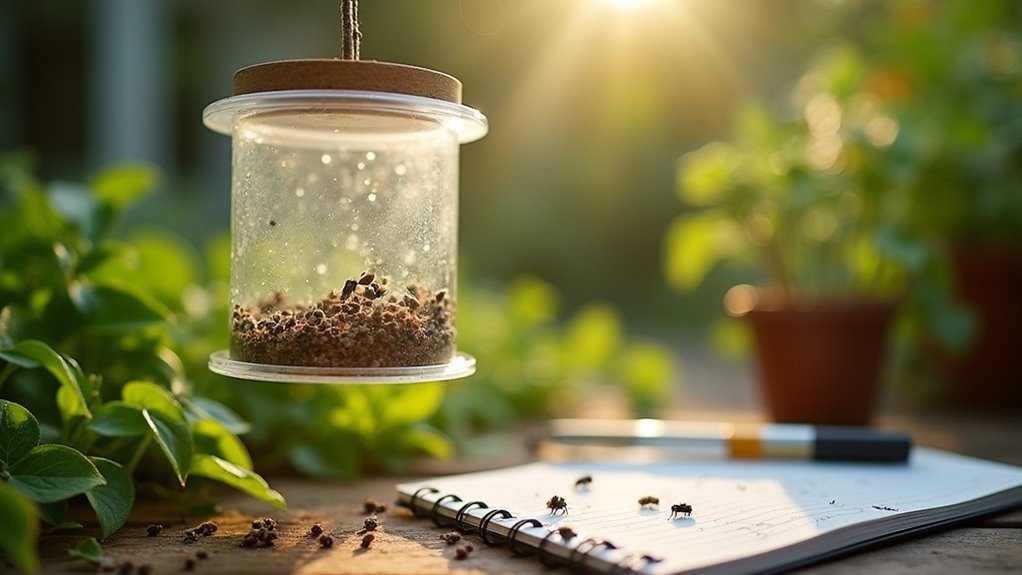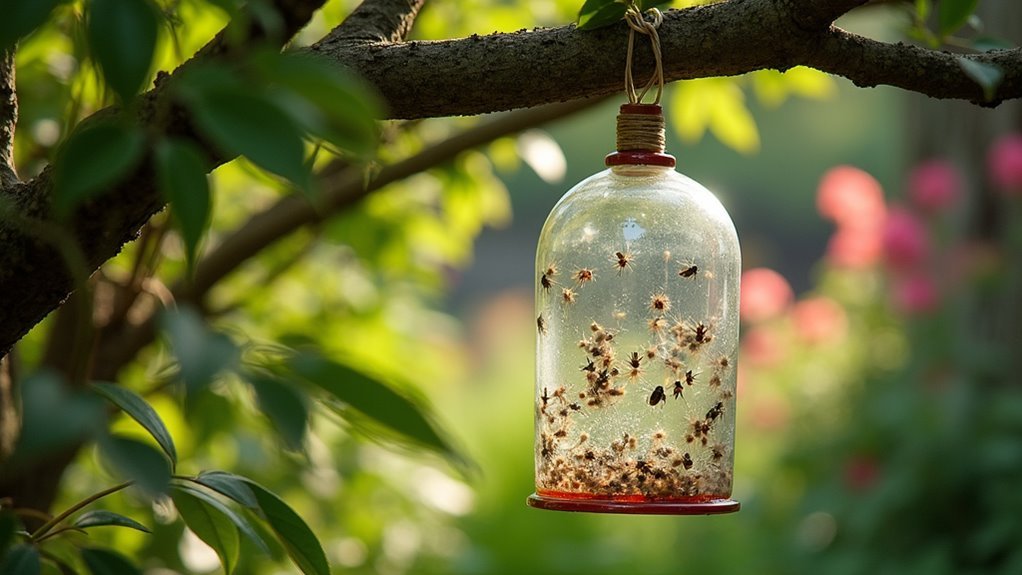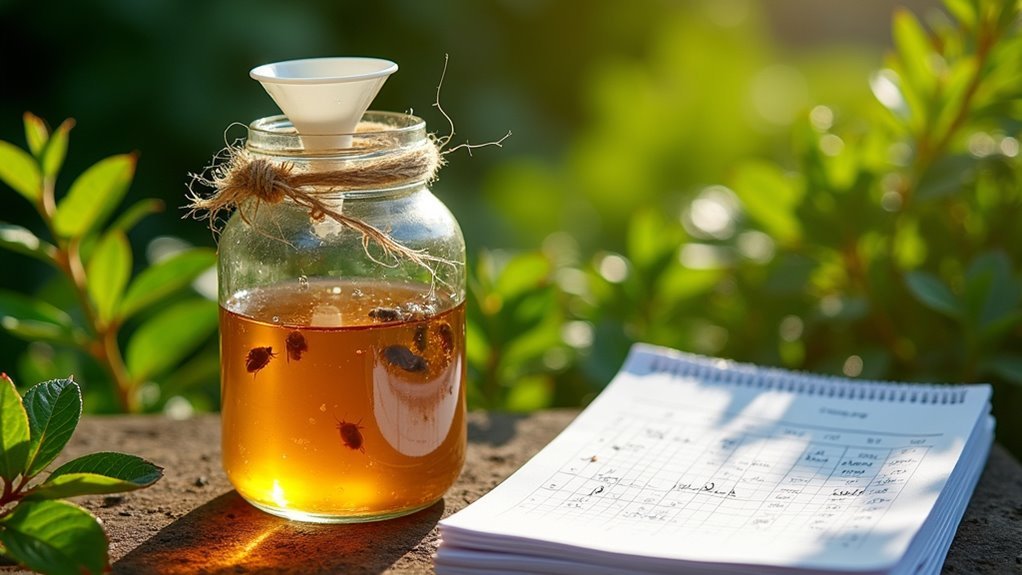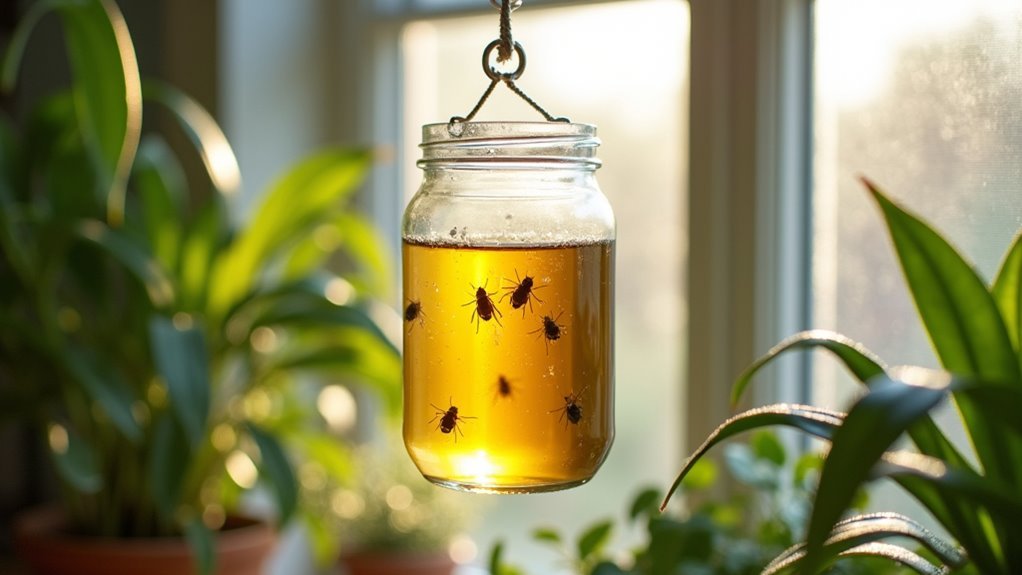You can build an effective fly trap using a clear plastic bottle with an inverted top as a funnel entrance. Use attractive baits like apple cider vinegar with dish soap, sugar water, or overripe fruit chunks. Place multiple traps near garbage cans and compost bins at varying heights. Record daily catches, bait types, and locations to identify population patterns and peak activity periods. Replace bait weekly and rotate trap positions every few days for ideal monitoring results that’ll help you master thorough population management strategies.
Understanding Fly Behavior and Population Patterns

Before you can build an effective fly trap, you need to understand what drives these persistent pests to specific locations. Flies rely heavily on their developed olfactory senses, making them highly attracted to sweet and smelly substances. This behavior is vital when attracting flies to your homemade fly trap, as proper bait selection determines your success.
Understanding fly behavior and their powerful sense of smell is the foundation for creating any successful homemade trap.
You’ll also need to take into account their rapid reproduction rate – female flies produce 1500-2500 offspring within just 30 days. This explosive breeding cycle means populations can surge quickly without effective management.
Flies exhibit specific behavioral patterns that impact trap placement. They prefer landing under surfaces and use chemotaxis for navigation.
Flying at speeds up to 8 kph, they’re agile enough to evade poorly positioned traps, making strategic placement in high-traffic areas essential.
Essential Materials for Building Your Monitoring Trap
You’ll need three key categories of materials to construct your fly trap effectively.
Start by gathering recycled bottle components, particularly a clear plastic bottle that’ll serve as your trap’s foundation.
Next, you’ll select effective bait options and assemble the necessary tools to put everything together properly.
Recycled Bottle Components
Three simple materials transform any discarded plastic bottle into an effective fly monitoring station.
You’ll need a clear plastic bottle with a wide mouth, making it easier to cut and invert the top section. The bottle’s transparency allows you to monitor trapped fruit flies and gauge population levels effectively.
Cut the bottle approximately one-third from the top, then invert this section into the base to create a funnel entrance. This design lets flies enter easily but prevents their escape. The inverted top acts as a one-way passage that exploits flies’ natural behavior patterns.
You’ll also need attractive bait like overripe fruit, sugary liquids, or fermenting substances.
Optional dish soap reduces surface tension, ensuring flies drown quickly upon contact with the liquid bait.
Effective Bait Options
Several bait types will dramatically increase your trap’s success rate by appealing to different fly species’ feeding preferences. For effective bait options, you’ll want sweet substances like sugar water, honey, or overripe fruit that mimic natural food sources.
Apple cider vinegar works exceptionally well for fruit flies—add a few drops of dish soap to reduce surface tension and prevent escapes. Raw meat scraps effectively target flesh flies that feed on decomposing proteins.
When using solid baits, keep them partially visible rather than fully submerged to maximize appeal. You’ll need to monitor and replace your bait every few days to maintain attractiveness and guarantee your trap continues working effectively against fly populations.
Assembly Tools Required
Before constructing your fly trap, gather the essential cutting and assembly tools that’ll guarantee a professional, durable result.
You’ll need a powersaw and dropsaw for precise timber cutting, plus an angle grinder or sharp snips to shape materials effectively. Don’t forget silicone sealant for weatherproofing and secure assembly.
Essential assembly tools include:
- Power cutting tools – Powersaw and dropsaw for accurate timber cuts
- Shaping equipment – Angle grinder or sharp snips for material modification
- Fastening materials – 50mm galvanised or 316 stainless chipboard screws for durability
Optional finishing tools like a planer and sander create smooth surfaces.
Whether you’re modifying a plastic bottle design or building from scratch, these assembly tools will guarantee your monitoring trap withstands weather conditions while maintaining effectiveness.
Selecting the Most Effective Bait Options
You’ll need to choose between sweet attractants like sugar water and honey versus fermented options such as apple cider vinegar, depending on your target fly species.
Protein-based baits like raw meat scraps work best for flesh flies, while fruit flies respond better to sugary or fermented substances.
Getting the concentration right is essential—too weak won’t attract flies effectively, while overly strong mixtures can actually repel them.
Sweet Vs Fermented Attractants
When choosing between sweet and fermented attractants for your DIY fly trap, understanding each option’s strengths will help you target specific fly species more effectively.
Sweet attractants like sugar water and overripe fruit work well for various fly species that crave sugary substances.
However, fermented attractants such as apple cider vinegar prove superior for fruit flies due to their strong, distinctive odors.
Consider these key differences:
- Sweet attractants appeal to multiple fly species but may attract broader insect populations
- Fermented attractants specifically target fruit flies with concentrated scent profiles
- Apple cider vinegar with dish soap creates the most effective combination by reducing surface tension
Since flies rely heavily on olfactory cues to locate food sources, fermented options typically outperform sweet baits for targeted fruit fly control.
Protein-Based Bait Options
While sweet and fermented attractants work well for common household flies, protein-based bait target different fly species with remarkable effectiveness. Raw meat scraps and fish remnants excel at attracting flesh flies, which seek decomposing protein sources for breeding.
You’ll find that spoiled or overcooked meat works particularly well since flies prefer the strong odor of decaying organic matter.
Enhance your protein-based bait by adding small amounts of sugar, creating a dual scent profile that appeals to various fly species.
Remember to replace these baits regularly—old bait loses its potency and becomes less attractive to flies.
Monitor which specific protein types work best in your environment, as effectiveness can vary based on local fly populations and environmental conditions.
Bait Concentration Guidelines
Most DIY fly traps fail because they use either too little bait to generate an attractive scent or too much that overwhelms and repels flies.
Following proper bait concentration guidelines guarantees your trap strikes the perfect balance between attraction and effectiveness.
For best results, you’ll want to measure your bait carefully:
- Apple cider vinegar mixture: Use 2-3 tablespoons of apple cider vinegar with 1-2 drops of dish soap in a shallow container
- Sugar water solution: Mix 1 part sugar with 3 parts water to create an enticing but not overpowering sweetness
- Fruit bait: Use small pieces of overripe fruit—about 1-inch chunks work best without creating excessive odor
Remember to refresh your bait every 2-3 days to maintain potency and prevent the concentration from becoming too strong.
Step-by-Step Construction Process
Building your fly trap requires careful preparation of materials and precise assembly techniques. Start by ripping recycled timber to 40mm x 40mm dimensions, ensuring pieces are dressed for uniformity. Cut structural grooves, then assemble legs and cross members for a stable base. Wax timber ends to prevent water absorption and extend your homemade trap’s outdoor longevity.
Use a frame belt clamp to fix sides together, pre-drilling countersink holes for durability. Create mitred corners for the screen lid, ensuring precise fits. Order high-quality mesh and cut to required dimensions for ideal catching performance.
Apply weather seal around the top to enhance trapping effectiveness. These homemade traps require all components to be securely sealed for maximum performance in monitoring fly populations effectively.
Strategic Placement for Maximum Data Collection

After constructing your fly trap, proper placement becomes the foundation of successful data collection.
Strategic placement of your fly traps requires targeting high-activity zones where flies naturally congregate. You’ll want to position traps near garbage cans, compost bins, and fruit bowls since these areas attract flies consistently.
To maximize your data collection effectiveness:
- Deploy multiple traps at varying heights – place some on countertops and others at floor level to capture different fly species
- Rotate trap locations every few days – this helps you identify activity hotspots and track population movement patterns
- Document daily catches – record the number of flies captured to analyze trends and determine peak activity periods
This systematic approach guarantees thorough population monitoring across your target area.
Recording and Tracking Population Numbers
Three essential components form the backbone of effective fly population monitoring: consistent data recording, systematic tracking methods, and regular analysis of your results.
You’ll need to create a simple chart logging the date and number of flies caught daily. This tracks population fluctuations and helps identify peak activity periods that’ll inform your future strategies.
Document which bait types you’re using in each trap alongside their corresponding catch numbers. Test different trap variations across various locations to compare trap effectiveness between designs.
Record everything systematically – bait performance, location success rates, and seasonal patterns.
Use this data to adjust your methods strategically. Increase trap numbers during peak seasons or switch baits when effectiveness declines, ensuring your monitoring system stays optimized.
Maintenance and Bait Replacement Schedule

Your monitoring data won’t mean much if you’re not maintaining your traps properly throughout the season. Consistent bait replacement and regular cleaning guarantee accurate results when monitoring the fly population.
Neglected traps produce worthless data—consistent maintenance and fresh bait are essential for reliable fly population monitoring throughout the season.
Follow this essential maintenance schedule:
- Check traps every few days to assess functionality and monitor capture rates.
- Replace bait weekly or sooner if it loses effectiveness or becomes contaminated.
- Clean traps thoroughly between uses to prevent mold growth that deters flies.
Use strong-smelling baits like apple cider vinegar mixed with dish soap for maximum effectiveness.
When using solid baits such as overripe fruit, keep them partially visible rather than fully submerged to maintain their attractiveness.
Proper maintenance ensures your population tracking remains reliable throughout your monitoring period.
Interpreting Your Monitoring Results
How effectively are your DIY fly traps performing, and what do the numbers really tell you about your pest control success?
Your daily monitoring data reveals vital patterns in trap effectiveness. When you record daily catch counts, you’ll notice fluctuations that indicate ideal bait performance periods.
Compare different bait types—sugar water versus apple cider vinegar—to identify which consistently attracts more flies.
Document the species you’re catching, as this information helps refine your bait strategy. House flies respond differently than fruit flies, requiring targeted approaches.
Track your results across multiple traps in consistent locations to establish baseline population density. During peak seasons like late summer, expect higher numbers.
A successful monitoring program shows progressive reduction in daily catches, indicating your traps are effectively controlling the local fly population.
Adjusting Trap Design Based on Seasonal Changes
As seasons shift throughout the year, your fly trap design must evolve to match changing insect behavior and population dynamics. Warmer months bring increased fly activity, requiring strategic adjustments to maintain effective population control.
Spring trap design should focus on:
Target breeding hotspots with increased trap density, sweet baits, and strategic placement near moisture sources during spring emergence.
- Increasing trap quantities near breeding sites like garbage and compost areas
- Using sweeter baits such as sugar water and overripe fruits to attract actively breeding flies
- Positioning traps closer to moisture sources where flies congregate
Summer demands larger trap openings and enhanced bait visibility to handle peak populations.
As autumn arrives, switch to stronger attractants like vinegar or meat scraps targeting food-seeking flies preparing for winter.
Regular maintenance becomes essential during seasonal changes. Replace baits frequently and monitor trap effectiveness, adapting your design strategy based on catch rates and local fly behavior patterns throughout each season.
Frequently Asked Questions
What Is the Best Bait for Homemade Fly Traps?
You’ll find apple cider vinegar with dish soap works best for fruit flies, while sugar water attracts most species effectively. Use rotting fruit for fruit flies or meat scraps for flesh flies depending on your target.
Does Vinegar and Dawn Get Rid of Flies?
You’ll effectively trap fruit flies using vinegar and Dawn together. The vinegar’s fermentation scent attracts them, while Dawn breaks surface tension, preventing escape. You’re creating a deadly combination that considerably reduces fly populations.
Do Fly Traps Reduce Population?
Yes, you’ll markedly reduce fly populations with effective traps. They capture breeding adults, preventing thousands of offspring since females produce 1,500-2,500 eggs. You’ll notice fewer flies when you consistently use and maintain traps properly.
What Liquid Attracts Flies the Most?
You’ll find apple cider vinegar works best for most flies, especially fruit flies. It’s fermented scent mimics their natural food sources. Add dish soap to break surface tension and you’ll catch even more flies effectively.
In Summary
You’ve now mastered the art of DIY fly monitoring with effective trap construction, strategic placement, and data collection techniques. Your homemade traps will provide valuable insights into local fly populations throughout the seasons. Remember to maintain consistent bait replacement schedules and adjust your trap designs as conditions change. By tracking patterns over time, you’ll develop a thorough understanding of fly behavior in your area and can make informed decisions about population management strategies.





Leave a Reply